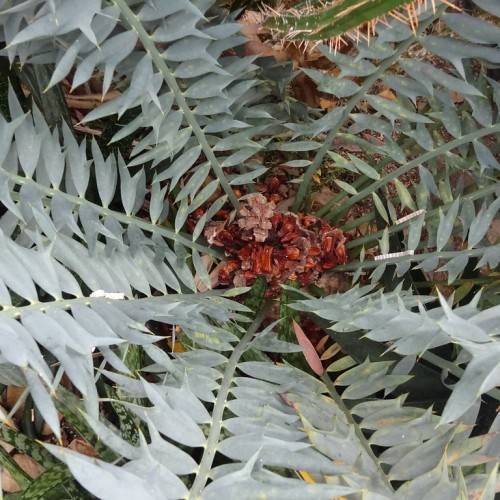
eastern Cape blue cycad
Encephalartos horridus
Cycle:
Perennial
Watering:
Minimum
Hardiness Zone:
10 - 12
Flowers:
Flowers
Sun:
Full sun
Cones:
Yes
Leaf:
Yes
Growth Rate:
Low
Maintenance:
Moderate
Drought Tolerant:
Yes
Salt Tolerant:
Yes
Thorny:
Yes
Care Level:
High
watering
Eastern Cape blue cycad plants prefer moderate water levels. They should be watered once every week or 2, depending on their soil and climate. A soil moisture meter should be used to determine the moisture content of the soil. In places with warm and dry climates, water more frequently. During its active growth phase in warm summer months, water more often to keep the soil moist but not soggy. In colder seasons, when the plant has stopped growing, water less often. Make sure plant receives adequate drainage to avoid root rot.
sunlight
The eastern Cape blue cycad (Encephalartos horridus) is native to the Eastern Cape region of South Africa, where it typically grows in moist, shady areas near waterways. It also grows in open areas that receive full sun. In its natural environment, the eastern Cape blue cycad will receive direct sunlight for 10-12 hours during the summer months. In areas where the seasonal climate is cooler, it may receive 6-8 hours of direct sunlight per day. In order to thrive, the eastern Cape blue cycad should be provided with bright, indirect sunlight during the summer months, and slightly less during the winter months. This can be achieved by placing the plant in a sunny, south-facing location, such as a sunny windowsill or balcony. During winter, the plant should be moved to a location that receives some shade in order to protect it from the cold. It should also be protected from strong winds and extreme temperatures. Overall, the eastern Cape blue cycad should receive 4-8 hours of direct sunlight per day throughout the year. In the summer months, the duration of direct sunlight should be increased to 10-12 hours per day.
pruning
The Eastern Cape blue cycad, Encephalartos horridus, is considered to be 1 of the most beautiful cycads. Pruning is an important part of caring for this plant species, but it should be done carefully to maintain the integrity of the plant. The best time to prune an Eastern Cape blue cycad is late winter or early spring. This is when the plant is just beginning to enter its active growth cycle. This will allow the plant to quickly recover from any pruning wounds and develop healthy new shoots and leaves. Pruning an Eastern Cape blue cycad should be done judiciously, as too much pruning can permanently damage the plant's growth and appearance. Pruning is only necessary if the plant is overgrown and the foliage is starting to look crowded. Remove only dead or damaged leaves, and trim branches that are growing in directions that you don't want. Trim foliage that is encroaching on other parts of the landscape, but avoid cutting away too much at once. If it looks like the plant needs a more extensive pruning, spread the pruning over several years. By following these pruning tips, you should be able to maintain the health and beauty of your Eastern Cape blue cycad for many years to come.
